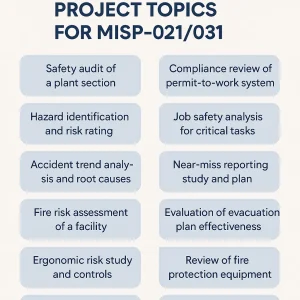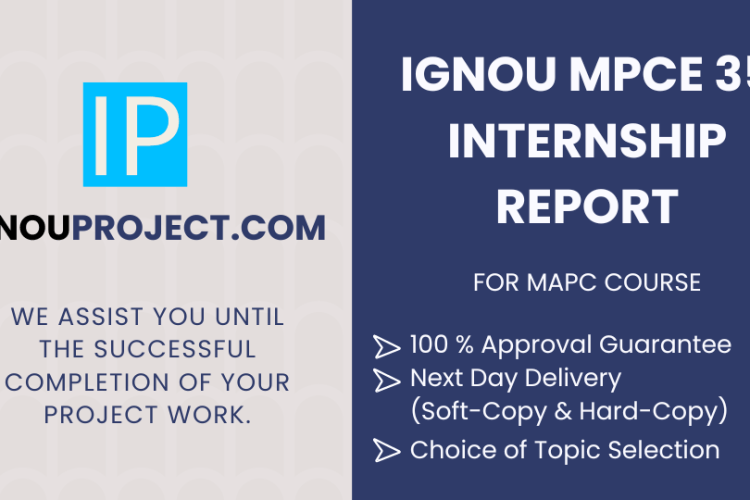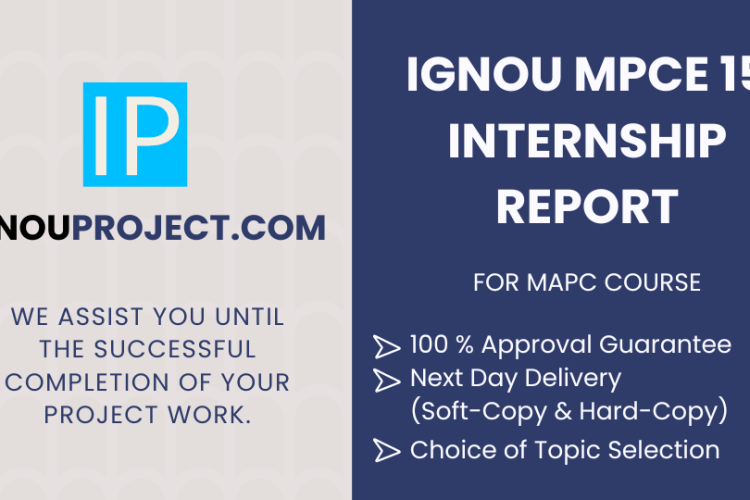
The IGNOU MSCIDS Project for MISP 021 and MISP 031 is a structured academic project in industrial safety that tests practical understanding of workplace risks, controls, and safety systems. It expects clear problem selection, sound data collection, correct analysis, and a well-presented report. A strong project also shows ethical handling of data and realistic safety recommendations.
The project component of the IGNOU MSCIDS Project (MISP 021/031) is a crucial part of the curriculum, allowing students to apply theoretical knowledge to practical problems in industrial safety. It focuses on minimizing the risks of accidents and ensuring a safe working environment in various industries.
This article explains project guidelines, code meaning, topic selection, synopsis writing, report format, guide selection, and the submission process.
IGNOU MSCIDS Project Guidelines (What the Project Must Follow)
The project should remain practical and safety-focused. It should address a real industrial safety issue and produce useful outcomes.
Key guidelines for the IGNOU MSCIDS Project for MISP 021 and MISP 031 include:
- Choose a real safety problem that can be studied with available access and data.
- Keep the work original. Paraphrase properly and avoid copied text.
- Use ethical methods. Take permissions for site visits, photos, interviews, and records.
- Protect privacy. Remove personal identifiers and sensitive business details.
- Use measurable objectives. Link each objective to specific data and analysis.
- Apply safety logic. Use hazard identification, risk assessment, and control measures.
- Present clear findings. Support conclusions with tables, charts, and observations.
Code Clarification: Understanding MISP 021 and MISP 031
The MSCIDS project work generally runs in two linked parts under two course codes:
- MISP 021 usually relates to project planning and proposal work, where the focus stays on selecting a topic, defining objectives, planning methods, and preparing the synopsis for approval.
- MISP 031 usually relates to the final project report, where the focus stays on fieldwork or study execution, data analysis, conclusions, and recommendations.
In simple terms:
- MISP 021 = plan it well
- MISP 031 = do it well and report it well
IGNOU MSCIDS Project Topic Selection
Topic selection decides the quality of the final output. A good topic is specific, measurable, and possible within the available time.
A topic should meet these conditions:
- Direct link to industrial safety and risk control
- Clear workplace setting (industry, plant, process, warehouse, construction site)
- Data can be collected through checklists, interviews, observation, or records
- Scope is realistic and not too broad
High-Value Topic Ideas for MISP 021 and MISP 031 (Industrial Safety Focus)
Safety systems and audits
- Safety audit of a plant section using a checklist and gap analysis
- Compliance review of permit-to-work system and risk controls
- Study of unsafe conditions and unsafe acts with control plan
Hazard identification and risk assessment
- Hazard identification and risk rating of a specific process (cutting, welding, mixing, material handling)
- Job safety analysis for critical tasks and control effectiveness
- Risk assessment of confined space work and control readiness
Accident and incident studies
- Accident trend analysis using incident records and root cause patterns
- Near-miss reporting study and improvement plan
- Investigation-based study of common injuries and prevention steps
Fire and emergency safety
- Fire risk assessment of a facility and emergency response readiness
- Evaluation of evacuation plan effectiveness through drills and observations
- Review of fire protection equipment placement and maintenance controls
Occupational health and ergonomics
- Ergonomic risk study for manual handling tasks and control measures
- Noise or dust exposure control review and awareness effectiveness
- PPE usage compliance study and improvement plan

Image: Trending MSCIDS Project Topics for MISP-021/031
Tip for topic narrowing: add a location + process + outcome. Example: “Risk assessment of solvent handling in the paint mixing area with control improvement plan.”
MSCIDS Synopsis Writing (MISP 021): Structure, Content, and Clarity
A synopsis acts as the project blueprint. It must show what will be studied, why it matters, and how it will be done.
Recommended Synopsis Format
- Title of the study (specific and short)
- Background (context of the workplace and safety issue)
- Problem statement (what is wrong and why it needs study)
- Aim and objectives (3–5 clear objectives)
- Scope and limits (site, process, time, exclusions)
- Methodology
- Study type: audit, case study, survey, observational study
- Sample: people, departments, records, shifts
- Tools: checklist, interview schedule, observation sheet
- Data plan
- Primary data: observations, interviews, questionnaires
- Secondary data: incident logs, training records, inspection reports
- Proposed analysis
- Risk matrix, frequency charts, Pareto, root cause categories
- Expected outcomes
- Main findings, gaps, and practical recommendations
- Work plan
- Week-wise or phase-wise timeline
- Attachments (if required)
- Draft checklist/questionnaire, permission note format, outline
Objective Writing Tips
- Write objectives that can be measured.
- Avoid vague words such as “to study safety.”
- Use verbs such as “identify, assess, compare, evaluate, recommend.”
Example objective set:
- Identify key hazards in a defined work area.
- Assess risk level using a consistent risk matrix.
- Evaluate existing control measures against good practice.
- Recommend practical controls with priority and ownership.
MSCIDS Project Report Format (MISP 031): Standard Structure
A well-structured report improves marks and readability. Use a clean layout, consistent headings, and simple language.
Suggested Report Chapters
Front pages
- Title page
- Student declaration (original work statement)
- Guide certificate (approval and supervision note)
- Acknowledgement (optional, brief)
- Abstract (150–250 words)
- Table of contents
- List of tables and figures
Main body
- Introduction
- background, problem, need, objectives, scope
- Industry/Workplace Profile
- process overview, work areas, people, basic safety setup
- Conceptual Review
- key safety concepts used in the study (risk, hierarchy of controls, audits)
- Methodology
- study design, tools, sampling, data sources, limitations
- Data Presentation and Analysis
- findings in tables/charts, risk ratings, trends, gap areas
- Discussion
- explain what findings mean and what causes the gaps
- Recommendations and Action Plan
- prioritized controls, responsible roles, time frame, monitoring method
- Conclusion
- objective-wise closure and clear outcome
- Limitations
- access limits, sample limits, data gaps (brief and honest)
End matter
- Appendices (checklists, forms, raw tables, photos if allowed)
- Glossary (optional)
Presentation Rules to Follow
- Use A4 pages, readable font, and consistent spacing.
- Number pages and label tables/figures.
- Keep figures clear and explain them in text.
- Avoid long paragraphs; use bullets where helpful.
Guide/Supervisor Selection in MSCIDS Project Work
The guide influences topic quality, methods, and report clarity. Choose a guide early to avoid delays.
Selection criteria:
- Guide has relevant knowledge in industrial safety, audit, risk, or safety systems
- Guide can support method selection and tool design
- Guide can review drafts within the project timeline
- Guide meets the MSCIDS programme’s eligibility and approval rules
Good practice for smooth supervision:
- Share a one-page concept note before finalizing the topic
- Fix review dates for synopsis and report drafts
- Keep a record of approvals and feedback changes
IGNOU MSCIDS Project Submission Process: Step-by-Step Workflow
Submission usually fails due to missed forms, missing approvals, or incorrect format. Use a checklist-driven approach.
Practical Submission Steps
- Finalize the topic and confirm it matches the course scope.
- Prepare and submit the synopsis under MISP 021 with required approvals.
- Collect permissions for workplace data, visits, or interviews (if needed).
- Complete data collection using the tools mentioned in the synopsis.
- Analyze data and prepare tables, charts, and risk summaries.
- Write the report under MISP 031 with correct chapter flow.
- Run a plagiarism check and rewrite any high-match sections.
- Get guide certificates and declarations signed as required.
- Submit in the prescribed mode (centre-based or portal-based as per current instructions).
- Keep proof of submission and a final soft copy for record.
Common Documents Usually Needed
- Synopsis approval/forwarding format (as applicable)
- Student declaration of originality
- Guide certificate and signatures
- Final report with proper front pages
- Annexures (tools, evidence summaries)
Tools used in MSCIDS Project
The tools used in a MSCIDS project (MISP 021/031) can vary widely depending on the specific focus and objectives of your research.
1. Risk Assessment and Management Tools
- BowtieXP: You use it to evaluate risks and visually handle them, finding and fixing any issues.
- @RISK (Palisade Corporation): It works with Microsoft Excel to do risk analysis using Monte Carlo simulation, which is helpful for measuring and managing risk in projects that involve workplace safety.
2. Data Analysis and Statistical Software
- SPSS (Statistical Package for the Social Sciences): This tool can help you use statistics to look at survey data or other types of quantitative data you’ve gathered for your study.
- Users can use R and RStudio, open-source software for graphics and statistical computing, to analyze and visualize data.
3. Geographic Information System (GIS) Tools
- ArcGIS: This tool provides maps and spatial analysis capabilities essential for environmental risk and safety analysis, particularly when geographic data holds significant importance to the study.
4. Safety Management Systems
- ISO 45001 Management Systems: It is important to know the rules and guidelines for managing health and safety at work, even though they are not tools in and of themselves. These software tools help ensure the rules are followed.
5. Environmental Health and Safety (EHS) Software
- Enablon: Provides ways to handle health and safety at work, risk, and rules, which can be helpful for projects that want to make businesses better at EHS.
- Intelex offers software for EHS management that can help with the study of best practices for safety management, compliance, and performance improvement.
6. Simulation Software
- Users can utilize ANSYS simulation tools for safety planning and risk assessment, effectively evaluating the structural integrity of buildings or the impact of environmental factors.
7. Survey and Questionnaire Tools
- SurveyMonkey or Google Forms: Useful for designing and distributing surveys to collect data from participants about safety perceptions, practices, or culture in industrial settings.
8. Document and Project Management Tools
- Microsoft Project: Helps in planning, organizing, and managing project tasks and resources.
- Mendeley or Zotero: This will help you keep track of your references and citations for the literature study part of your project.
FAQs (Frequently Asked Questions) in IGNOU MSCIDS Project for MISP 021 and MISP 031
What is the main aim of the IGNOU MSCIDS Project for MISP 021 and MISP 031?
It aims to test practical industrial safety skills through a planned study, data-based analysis, and realistic control recommendations.
Can the same topic be used for both MISP 021 and MISP 031?
Yes. The synopsis stage defines the topic and plan, while the final stage completes the study and report on the same approved topic.
What makes recommendations strong in industrial safety projects?
Strong recommendations are practical, prioritized, and linked to findings. They follow elimination, substitution, engineering controls, admin controls, and PPE.
Downloadable Resources
- IGNOU MSCIDS Project Synopsis Sample PDF
- IGNOU MISP 021 Project Sample PDF
- IGNOU MISP 031 Project Sample PDF
Conclusion
A high-scoring IGNOU MSCIDS Project for MISP 021 and MISP 031 depends on a feasible topic, a clear synopsis, disciplined data collection, and a report that converts findings into practical safety controls. Consistent formatting, ethical handling of data, and objective writing also improve evaluation outcomes.
For expert help with the IGNOU MSCIDS Project for MISP 021 and MISP 031, visit ignouproject.com and contact us to get topic shortlisting support, synopsis drafting assistance, report formatting guidance, and end-to-end submission support—aligned with programme requirements and academic standards.

